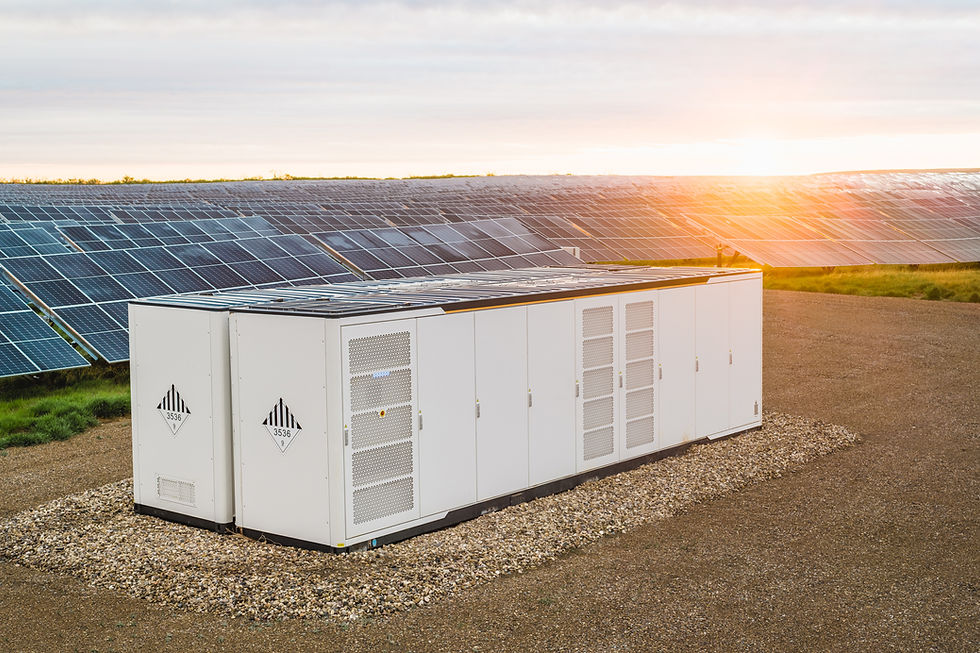Batteries Are the New Solar: And Our Next Leap for Climate Hope
- Gregory Andrews

- Oct 15
- 3 min read
Ten years ago, solar power was often dismissed as too expensive, too small-scale, too niche. Then the cost curve bent - steeply. In 2023, the world installed more solar than in 2021 and 2022 combined, and then 2024 smashed the record again. Now, batteries are tracing the same curve as solar.
Batteries are becoming the new solar: according to the Financial Times, prices are down over 95 per cent since 2010, and around 50 per cent lower than just 18 months ago. Each drop in cost fuels another surge in installations. As a result, battery storage is now scaling faster than anyone predicted. Last year, global additions roughly doubled, and Bloomberg expects a five-fold increase by 2030. This isn’t speculation, it’s happening in real time. On some evenings, California’s batteries now cover about a quarter of peak demand. And China has more grid-scale storage in development than the rest of the world combined. This is what a clean-energy flywheel looks like when it catches momentum.
Australia is also a part of the revolution. According to the Australian Energy Market Operator (AEMO), there are now 50 plus grid-scale battery projects operating, under construction or approved across our National Electricity Market - tens of gigawatts of firming capacity.
South Australia’s Hornsdale Power Reserve proved in 2017 that batteries could stabilise the grid in milliseconds and at a much lower cost than gas. Expanded to 150 MW/194 MWh, it remains a benchmark worldwide. Victoria’s Victorian Big Battery near Geelong has a capacity of 300 MW/450 MWh and stores about an hour of consumption for over a million homes on an energy-equivalent basis. New South Wales’ Waratah Super Battery will soon be the Southern Hemisphere’s largest network-standby asset. So battery storage is no longer experimental - it’s already essential infrastructure.
Why Batteries Change Everything
Batteries soak up cheap wind and daytime solar and deliver it in the evening peak. They respond to disturbances almost instantly, keeping frequency tight and the lights on. And they scale fast: 12 to 18 months from decision to operation for large units. This is vital as ageing coal fired power stations retire and become unreliable.
Household storage is booming too. Hundreds of thousands of Aussie homes now pair rooftop solar with a battery or join a virtual power plant (VPP). My family has a battery - and the effect is tangible. We save money, ride through outages confidently, and cut emissions every day. Stored sunshine is our quiet independence. Like many households, our battery allows us to cut grid imports dramatically while also helping to stabilise the wider system.
The End of Base-Load Thinking
The century-old “base-load” model of big coal or nuclear plants running flat out belongs to a one-way, inflexible grid. Today’s grid is about flexibility: fast-ramping batteries, responsive renewables, and smart demand that matches net-load in real time.
We don’t need plants burning fuel 24/7 just to keep turbines spinning; we need firm, affordable and dispatchable capacity that appears precisely when it’s required. Big batteries and home batteries provide that - and renewables supply the fuel.
Active Hope in Action
When I look at the surge in battery storage, I see Active Hope - not the passive kind that waits for someone else to act, but the determined, data-driven kind that builds a better future each installation at a time.
Every new battery is a declaration that fossil fuels’ monopoly on so-called reliability is over. Every megawatt-hour of stored solar is a vote for energy independence and affordability, and for the idea that we can power the world without wrecking it.
Near Geelong, in the red dust of the Pilbara, and on the rooftops of ordinary Aussie homes, the revolution is humming quietly. You can’t always see it. But you can feel its momentum.
The sun and the wind gave us clean generation. Batteries are now giving us clean reliability. Together they make the fossil-and-nuclear era of “base-load” power redundant. That’s something worth believing in - and building on.





Comments